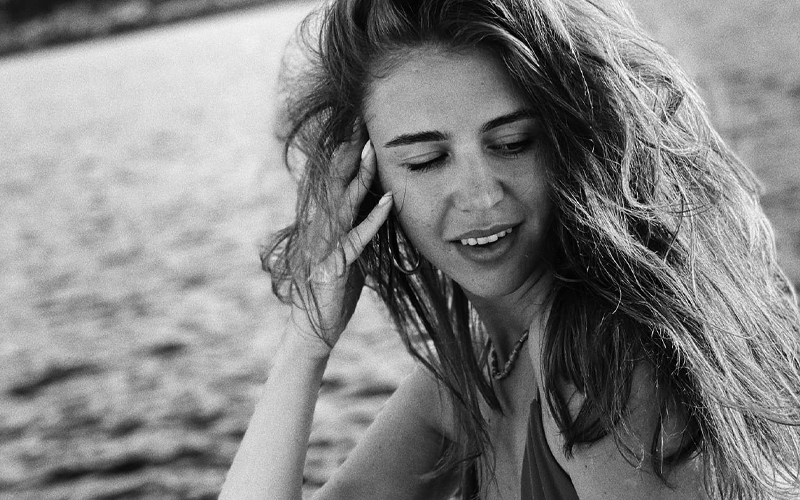
350 volte per dire GRAZIE A TE, DISCORSIVO! – 350 times to say THANK YOU, DISCORSIVO!
Per Virginia Woolf, vi sono momenti in cui la “vela della vita” s’affloscia. Però, si potrà ancora guardare “la scogliera dell’esistenza”. Simbolicamente, quanto il ricordo consentirebbe di preservare la giovinezza? Se volessimo percepire una maturità, nello scatto di Lera, allora noi partiremmo dal fianco destro. L’occhio si chiude, quasi ad “ascoltare” (in sinestesia) la mano pensierosa, contro la tempia, nella riconfigurazione complessiva d’un cuore (complici le dita ad “arterie”). E’ il dettaglio più intimistico dello scatto. Naturalmente, Lera ha la “fortuna” della gioventù, con sé… Lei sorride, probabilmente mentre si gode un’escursione in barca. Pare che le braccia “si montino” assieme nel dispiegamento d’una vela. Ma la linea dell’orizzonte è storta, così da far “afflosciare” il busto già accovacciato di suo.
According to Virginia Woolf, there are moments in which “the sail if the life” sags. However, we still could watch “the cliff of the existence”. Symbolically, how much would the memory allow preserving the youth? If we wanted to perceive a maturity, in the Lera’s shot, so we should start from the right side. The eye is closed, almost to “listen” (in a synesthesia) the thoughtful hand, against the temple, in the overall configuration of a heart (complicit the fingers in “arteries”). This is the detail more intimistic of the shot. Of course, Lera has the “luck” of the youth, on her side… She smiles, probably while she is enjoying a boat excursion. It seems that the arms “are assembled” together in an unfolding sail. But the horizon line is crooked, so allowing the bust, already crouched on its side, to “sag”.
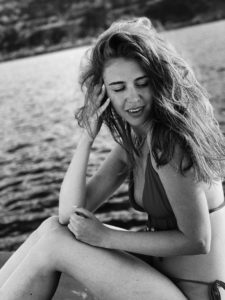
Per Marco Pola, liricamente noi seminiamo l’ombra del nostro corpo come da un carro che perde i fili di fieno, mentre all’opposto lo sfavillio delle costellazioni “gioca” ad ingrandirsi in altezza. Chi vive, nel contempo procede verso la morte. C’è la famosa costellazione del Grande Carro, la cui luce “si sfilaccia” al fine d’orientarci. Simbolicamente noi cercheremo di resistere al nostro deperimento. Se la balla di fieno fosse un “astro” allo stato vegetativo, allora essa non donerebbe “un’illuminazione”, ma avrebbe pur sempre il ciclo della vita. Alena ha posato all’aperto, nel caratteristico ambiente d’una steppa. Lei è seduta in modo “pericolante”, sopra una balla di fieno. Pare che il vestito “ingrandisca” il foulard in testa, in un parallelismo fra le forme a selce, e complice il mantenimento del tono rosso. Nell’insieme, se una freccia potesse orientare, allora essa lo farebbe convintamente verso il basso… Le mani s’intreccerebbero fra di loro, mancando la rincorsa delle staffe. Si percepisce una stasi introspettiva, perché il rosso è sanguigno, e “ruba la scena” all’orizzonte astrattamente lontano. Sullo sfondo, la steppa ha montagne dalla forma quasi “lunare”. Il tono dei capelli è lo stesso di quello per il fieno. Alena guarda lontano, e forse orientandosi grazie alla virtualità d’un vulcano, allo sfavillio d’una stella in terra.
According to Marco Pola, lyrically we sow the shadow of our body, like it came from a cart which loses the strands of the hay, while contrarily the twinkling of the constellations “plays” with an enlargement in height. Somebody who lives, in the same time proceeds into the death. There is the famous constellation of the Charles’s Wain, whose light “is frayed” in favour of our orientation. Symbolically we would try to resist to our deterioration. If the hay bale were a “star” in the vegetative state, so that one would not give “an illumination”, but it would however have the life cycle. Alena posed outdoors, in the typical setting of the steppe. She is sitting in a “teetering” way, over a hay bale. It seems that the dress “enlarges” the foulard in the head, from a parallelism between the shapes of a flint, and with the complicity of the red tone, which is maintained. Overall, if an arrow could orient, so that one would realize its goal with conviction downwards… The hands would be woven together, because the run-up of the stirrups is lacking. We perceive an introspective stasis, because the red is a sanguineous tone, and “steals the spotlight” against the horizon abstractly distant. On the background, the steppe has the mountains with a shape almost “lunar”. The tone of the hair is the same as the tone of the hay. Alena watches in the distance, and maybe orienting herself through the virtuality of a volcano, in the twinkling of a star in the earth.

Per Dylan Thomas, la palla lanciata giocando nel parco, da bambino, non è ancora scesa al suolo. Tutti gli insegnamenti ricevuti forse serviranno a poco, innanzi ai “problemi” sempre nuovi che troviamo vivendo. Ma a volte si potrà restare in parte bambini? Alice è stata inquadrata in una vecchia stanza, senza arredamenti. Lei gioca, trattenendo in mano il volo d’una palla, disegnata dall’artista Mattia Gardenal. Ma quanto varranno le “classiche” citazioni (per esempio da Chaplin)? Ci pare che i triangoli della palla accrescano la riflessione della finestra, consentendo al cielo di scendere nel… “nucleo” del suo pianeta, affinché si mostri come la gravità sia essenzialmente un “orizzonte”, per un punto di vista sempre volubile. Una vetrata certo abbellisce. Essa qui fungerà da “stimolo” simbolico, affinché noi impariamo a far “ruotare” tutti i tradizionali “davanzali” dei nostri pregiudizi. E’ la dialettica del cielo nucleare, mentre Alice indossa il tono giallo del sole, dovendo praticare una vitalità.
According to Dylan Thomas, the ball thrown playing in the park, when we were kids, still not went down to the ground. All the teachings that we received maybe will be not useful, in front of the always new “problems” that we find in our life. But could we sometimes remain partially kids? Alice was framed inside an old room, without the furniture. She plays, holding in the hand a ball in the air, drawn by the artist Mattia Gardenal. But how much the “classic” quotes (for example from Chaplin) will be valid? It seems to us that the triangles of the ball increase the reflection of the window, allowing the sky to descend into the… “nucleus” of its planet, to show how the gravity is essentially a “horizon”, for a point of view always changeable. A glass window of course embellishes. Here, it will function as a symbolic “incentive”, allowing us to learn how we can “rotate” all the traditional “windowsills” of our prejudices. This is the dialectics of the nuclear sky, while Alice wears the yellow tone of the sun, having to practice a vitality.

Ferlinghetti immagina che una donna “si stiracchi” la dolce anatomia, lasciando cadere una calza. A volte, la femminilità richiede che si sappia come rendere sensuale il gesto più naturale. Lo scatto di Monica è in bianconero. Lei ha posato al piano americano, ma di ¾ ed alzando le braccia oltre la testa. Il costume a righe orizzontali sarebbe esteticamente balneare… A “straniare” abbastanza i codici del fashion, subentra un largo “laccio”, che connette il seno al fianco destro. Qualcosa da percepire come una “calza”, quantunque la bellezza del corpo giovane e snello riesca a “mitigare” ogni “grigiore” del freddo inverno (se lo scatto è in bianconero).
Ferlinghetti imagines that a woman “stretches” the sweet anatomy, letting a stocking fall. Sometimes, the femininity requests that we know how to make sensual the gesture most natural. The shot of Monica is in black and white. She posed in a cow-boy shot, ma in ¾ view and raising the arms beyond the head. The costume in horizontal stripes would be aesthetically for bathing… A large “lace”, which connects the breast to the right side, moves in, allowing quite well the codes for the fashion to “become estranged”. Something that we perceive like a “stocking”, although the beauty of the young and slim body is able to “mitigate” every “greyness” of the cold winter (if the shot is in black and white).
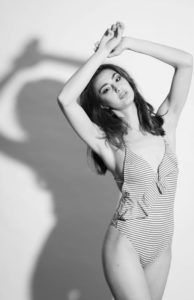
Per Milo De Angelis, liricamente qualcuno tende l’acciarino sulla tanica, con l’accortezza d’una manualità “a strappi”, e come la “texture granulosa” per mascherare una coscienza che “piomba”. Simbolicamente, una società funzionerà se tutti avranno un ruolo abitudinario? Ma questo alla lunga rischia di fossilizzare la creatività costante, sotto l’ispirazione critica. Irina è stata inquadrata in piedi, e camminando in mezzo ad un piazzale che, se non considerassimo l’autovettura dietro al corpo, penseremmo riguardare un aeroporto. Pare una scena cinematografica, da crime story, con la ragazza che deve fare una consegna “delicata”! Il corpo è perfettamente incrociato con l’autovettura (dal mercato americano). Irina reggerebbe una tanica in luogo d’una valigia, chissà quanto ad “accendere” la storia del film (fuori dalla quotidianità sociale). Ci sarà “l’acciarino” delle gambe snelle ed affusolate. Il volto s’abbassa un po’, a guardare meglio dove si mette il piede, forse con grinta o forse (all’opposto) con soggezione. La tanica ha una vernice verde, che “unge” la naturalità dell’erba. La risoluzione fotografica è al fuori fuoco per l’intero sfondo.
According to Milo De Angelis, lyrically somebody stretches a fire striker on a jerrycan, with the care of a manual skill “in tears”, and like a “grainy texture” to mask a consciousness that “swoops”. Symbolically, will a society function if all the people will have a habitual role? But in the long run that situation risks fossilizing the constant creativity, under the critical inspiration. Irina was framed standing, and walking in the middle of a square that, if we had not considered the car behind the body, we would think about an airport. It seems the scene of a film, from a crime story, with the girl who has to make a “thorny” delivery! The body is perfectly crossed with the car (from the American market). Irina would hold a jerrycan in the place of a suitcase, who knows how much to “turn on” the story of the film (out of the social everyday life). There will be “a fire striker” of the legs slender and tapered. The face bends a bit down, to watch in the better way where she puts her feet, maybe with grit or rather (contrarily) with subjection. The jerrycan has a green paint, which “anoints” the naturalness of the grass. The resolution of the photography is in out of focus for the entire background.
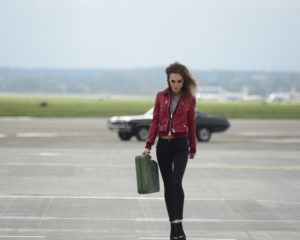
Per Alejandra Pizarnik, liricamente non bisogna vincere la calamita, perché altrimenti il sandalo in corda si sfilaccia. Prima d’agognare col corpo lo straordinario, forse siamo costretti a razionalizzare con la mente lo ordinario… Più in generale, la poetessa ci avrà descritto la dialettica fra il sogno ed il giorno. Jessica è stata inquadrata in strada. Lei indossa abiti neri ed in pelle. Lo sguardo è molto deciso. Noi immaginiamo che le mani “si carichino” il peso della sottoveste, cercando il “giusto aggancio” sugli orli, un po’ a “distorcere” la “calamita” decorativa sull’addome. La scarpa sinistra è chiaramente slacciata. Dunque Jessica ha posato nel complesso portandosi dietro un “peso” difficile da reggere? La fibbia a “calamita” è sdoppiante, in via troppo “enigmatica” per potervi “allacciare” una risposta. In questa fotografia prevale il “sogno appena grigio” d’un cielo che “corre” dal blu soleggiato al nero stellato, e tramite l’asfalto.
According to Alejandra Pizarnik, lyrically we should not defeat the magnet, because otherwise the rope sandal frays. Before we yearn for the extraordinariness, with the body, perhaps we are forced to rationalize the ordinariness, with the mind… More in general, the poetess would have described the dialectics between the dream and the day. Jessica was framed on the road. She wears black leather clothes. The gaze is very determined. We imagine that the hands “burden” themselves with the underskirt, searching for the “right hooking” on the hems, a bit to “distort” the decorative “magnet” on the abdomen. The left shoe is clearly unlaced. So did Jessica pose as a whole “carrying” something around, and with difficulty? The buckle as a “magnet” is in a doubling, in a way too much “enigmatic” to allow us to “lace” there an answer. In this photography, the “dream just grey” of a sky which “runs” from the sunny blue to the starry black, and through the asphalt, prevails.

Il poeta Tony Curtis immagina che una ragazza si corichi a letto, e come “un’attinia gracile” addosso ad “un cuscino di corallo”. Ma se lei fosse ammalata, allora noi avremmo il simbolismo d’un naufragio (con i “deliri” della febbre). Elena posa per uno scatto in bianconero. Lei è coricata a letto, ed avendo la testa sul cuscino. Al centro, fra le coperte “riaffiorerebbe” un “grembo” d’attinia (in corrispondenza col busto). Pare che Elena strabuzzi un po’ gli occhi, chissà quanto “pescata” dal risveglio! In realtà la fotografia si percepisce in via più glamour, grazie alla “corolla” complessiva fra i cuscini e gli arti.
The poet Tony Curtis imagines that a girl lies down on the bed, and like “a frail anemone” against a “coral pillow”. But if she would be ill, so we would have the symbolism of a shipwreck (with the “deliriums” of the fever). Elena poses for a shot in black and white. She is lying down on the bed, and having the head on the pillow. In the middle, between the blankets a “womb” of anemone “would resurface” (in correspondence with the bust). It seems that Elena opens her eyes wide, who knows how much after an awakening “surprised” her! Actually the photography is perceived in a way more glamour, through the overall “corolla” between the pillows and the limbs.

Secondo William Piper, pilotare un aereo è assai meno faticoso che guidare l’autovettura. Solo nel primo caso, non bisognerà mai preoccuparsi dei segnali stradali, degli animali che attraversano la carreggiata, o dei “gentiluomini” che all’incrocio passano col rosso! Kara è stata inquadrata in mezzo ad un orto. Lei passeggia fra alcune banderuole da bambini, dall’asta bassa e col disegnino dell’aereo, pilotato in via antropomorfa (tipo da un gatto). Nel complesso, si percepisce un ingorgo “tranquillamente” favolistico. La mano sinistra di Kara pare in grado d’attivare una delle eliche. Il tono del blu accomuna il vestito alla plastica, aggiungendosi al tradizionale “trio” del verde-giallo-rosso, per il semaforo. In cielo, basta rispettare unicamente il primo…
According to William Piper, to fly an airplane is far less strenuous than to drive a car. Only in the first case, we will not have to be worried about the traffic signs, the animals that cross the carriageway, or the “gentlemen” who runs a red light at the intersection! Kara was framed in the middle of a vegetable garden. She walks between some wind vanes for kids, with the short shaft and the little drawing of an airplane, flown in anthropomorphic way (as by a cat). Overall, we perceive a blockage “calmly” fabulous. The left hand of Kara seems able to activate one of the propellers. The blue tone is present both in the dress and in the plastic, adding itself to the traditional “triad” of the green-yellow-red, for a traffic light. In the sky, we will have only to respect the first tone…
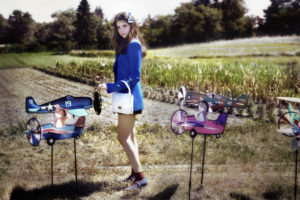
Secondo un celebre aforisma (falsamente attribuito a Guy De Maupassant), la spugna cancella il passato, la rosa addolcisce il presente ed il bacio saluta il futuro. Lo scatto di Naian è in bianconero. Lei posa in piedi, e tiene le braccia incrociate in “rinforzo” di losanga sulla gonna. Di contro, il volto sembra “cedere” all’indietro. Si può immaginare l’apri e chiudi “spugnoso” delle mani, il “calice” floreale del top, il bacio che “si catapulta” dalla bocca. In chiave percettiva la losanga è “grattante”, la pelle nuda fatica ad “addolcire” la resa fotografica in bianconero, il collo “arresta” il saluto della testa. Nel complesso, Naian esibisce un’interiorità “ammanettata”, chissà quanto allo “sforzo” di liberarla. Forse ci rimarrà il suo ascolto, mentre l’orecchio sinistro saluterebbe anche più del bacio “catapultato”.
According to a famous aphorism (wrongly attributed to Guy De Maupassant), a sponge erases the past, a rose sweetens the present and a kiss greets the future. The shot of Naian is in black and white. She poses standing, and keeps the arms intersected as “a reinforcement” from the lozenge to the skirt. On the contrary, the face seems to be “ceding” backwards. We can imagine the open and close “spongily” of the hands, the floral “calyx” of the top, the kiss that is “catapulted” by the mouth. In a perceptive key the lozenge is “scratching”, the bare skin is struggling to “sweeten” the photographic resolution in black and white, the neck “stops” the greeting from the head. On the whole, Naian shows a “handcuffed” inwardness, who knows how much in the “effort” to release it. Perhaps its listening will remain to us, while the left ear would greet even more than the “catapulted” kiss.
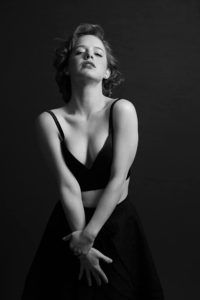
Per il poeta Tapparo, bisogna amare una tettoia quando essa è sola ed inutile, perché, se piove o tira vento, comunque si preferisce… evitarla. Inoltre, vale una forma di riconoscenza. La tettoia ci protegge, mentre essa può unicamente attendere il “fremito verde” dell’alba, dopo una “cova” nel vuoto notturno. Margo è stata inquadrata al piano americano. Lei gira il volto, guardando verso il basso. L’abito unico di jeans ha un lungo “strappo”, in quanto più sbottonato che scollato. Margo è stata inquadrata sotto una tettoia, molto probabilmente urbana, da parcheggio o stazione. Contro la predominanza dell’oscurità, immaginiamo che la modella un po’… “se la tiri”, donato un “fremito sexy” alla luce d’un verde appena “fiacco”, sulla “scollatura” oltre i pilastri. Qui la bellezza femminile si farebbe “covare”, e da uno “scudo” dell’intimità ad uno “sboccio” dell’eleganza.
According to poet Tapparo, we have to love a canopy when it is alone and useless, because, if it rains or it is windy, however we prefer to… avoid that one. In addition, a form of thanksgiving is valid. A canopy protects us, while that one can only wait for the “green quiver” of the dawn, after a “brood” in the nocturnal void. Margo was framed through a cow-boy shot. She turns the face, watching downward. The unique dress in jeans has a long “tear”, because it is more unbuttoned than open-necked. Margo was framed under a canopy, most likely urban, for a parking or a station. Against the predominance of the darkness, we imagine that the model a bit…is “bragging”, offering a “sexy quiver” to the light in a green only “weak”, on the “neckline” beyond the pillars. Here the female beauty would allow its “brood”, and from a “shield” of the intimacy to a “blooming” of the elegance.

Per il filosofo Benjamin, la città moderna si schiude per il passante come un paesaggio senza più le soglie. Ovunque si vada, sempre s’incontreranno strade e case. Anzi funzionerebbe una sola soglia: quella dal mero vagabondaggio all’utile ricognizione (senza i tradizionali punti d’orientamento: le montagne, i fiumi, i litorali ecc…). Sofia è stata inquadrata mentre cammina sulle strisce pedonali, in città. Immaginiamo che le gambe “si schiudano” al passo. Quelle “scalceranno” la vernice in basso, alternativamente bianca e gialla, secondo il codice internazionale d’una tonalità che, in natura, appartiene alla vitalità dell’uovo. La prospettiva dell’inquadratura addirittura c’ingannerebbe, lasciando che l’intero corpo di Sofia “penda”. L’animale che nasce da un uovo, tende immediatamente a guardarsi intorno. Sofia è stata inquadrata in una giornata piovosa. Così mancheranno le “soglie consumate” delle insegne pubblicitarie, coi pochi pedoni in giro da invogliare agli acquisti. Anzi la giacca mossa dal vento si configura “a campana”, in attesa di farsi suonare dalle gambe a “batacchio”, se lo sguardo avrà trovato “l’idea giusta” sulla destinazione finale.
According to the philosopher Benjamin, a modern city opens up in favour of the pedestrian like a view that no more has the thresholds. Everywhere we go, always we will meet roads and houses. Rather an only one threshold would function: the threshold from a mere wandering to a useful reconnaissance (without the traditional points of orientation: the mountains, the rivers, the seaboards etc…). Sofia was framed while she is walking on the pedestrian crossing, in the city. We imagine that the legs “open up” in step. Those “will buck” with reference to the paint below, alternately white and yellow, according to the international code about a tone which, in nature, belongs to the vitality of the egg. The perspective of the framing even would deceive us, letting the entire body of Sofia to “hang”. An animal which is born from an egg, immediately tends to look around. Sofia was framed during a rainy day. So the “consumed” thresholds of the advertising signs will be lacking, with a few of pedestrians around able to be tempted to a purchase. Rather the jacket moved by the wind is configured “in a bell”, awaiting its ring by the legs in a “clapper”, if the look will find “the right idea” about the final destination.
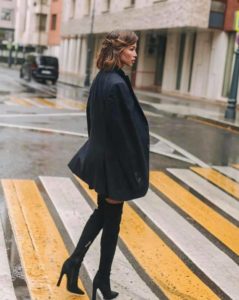
Bibliografia consultata – Annotated bibliography:
E. BORGNA, Di armonia risuona e di follia, Feltrinelli, Milano 2012, p. 72
M. POLA, Opera poetica, La Finestra, Lavis 2006
D. THOMAS, Poesie, Einaudi, Torino 1965
L. FERLINGHETTI, A coney island of the mind, Minimum Fax, Roma 2018
M. DE ANGELIS, Tutte le poesie: 1969-2015, Mondadori, Milano 2017
A. PIZARNIK, Poesia completa, LietoColle, Faloppio 2018
E. SEMINO, Language and world creation in poems and other texts, Routledge, Londra 2014
S. SCHIFF, Saint-Exupery: a biography, Random House, New York 2011
T. BARISON, Rosae, rosarum, rosis, Vistacasa – Giornale, Numero 83 / Novembre e Dicembre 2017, p. 15
R. L. TAPPARO, L’altrove della poesia: 1991-2014, Leone & Griffa Editore, Biella 2014
L. URRU, Il fantasma tra i ciliegi: topografie di primavera a Tokyo, Liguori, Napoli 2007, p. 47
Nota biografica sui ventitre artisti recensiti – Biographical sketch about the twenty-three artists:
La modella Lera Piriienko vive a Kiev (Ucraina). Lei ha studiato Pubbliche relazioni, ed è molto interessata all’arte.
The model Lera Piriienko lives in Kiev (Ukraine). She studied Public relations, and she is very interested in art.
La fotografa Ira Chernichenko nasce a Mariupol (Ucraina). Lei ha studiato Marketing digitale.
The photographer Ira Chernichenko was born in Mariupol (Ukraine). She studied Digital marketing.
La modella Alena Gorbacheva è russa. Lei ha studiato Management dell’economia sociale, ed attualmente lavora come docente universitaria a Krasnojarsk.
The model Alena Gorbacheva is Russian. She studied Managament for social economy, and currently works as academic teacher in Krasnoyarsk.
Il fotografo Alexander Gorbachev è russo. Egli scatta solo in modo amatoriale.
The photographer Alexander Gorbachev is Russian. He shoots only in amateur way.
La modella italiana Alice Pozzo nasce ad Udine. Lei studia Giurisprudenza.
The Italian model Alice Pozzo was born in Udine. She studied Jurisprudence.
La fotografa italiana Laura Zambelli viene da Portogruaro (Venezia). Lei è appassionata di viaggi.
The Italian photographer Laura Zambelli comes from Portogruaro (Province of Venice). She is fond of travelling.
www.laurazambelli.it
La modella italiana Monica Montobbio viene da Silvano d’Orba (Alessandria). Lei partecipa anche ai concorsi di bellezza.
The Italian model Monica Montobbio comes from Silvano d’Orba (Province of Alessandria). She also partecipates in the beauty contests.
Il fotografo italiano Eugenio Vittorio Luti vive a Milano. Egli è specializzato sui matrimoni.
The Italian photographer Eugenio Vittorio Luti lives in Milan. He is specialized in weddings.
www.eugenioluti.com
La modella Irina Salyuta viene da Kiev (Ucraina). Lei ha studiato Amministrazione aziendale.
The model Irina Salyuta comes from Kiev (Ukraine). She studied Business administration.
Il fotografo Sergey Yushkov viene da Kiev (Ucraina). Egli scatta in vari campi: per il fashion, il commerciale, le celebrità, il still-life ecc…
The photographer Sergey Yushkov comes from Kiev (Ukraine). He shoots in different fields: for the fashion, the commercial, the celebrities, the still life etc…
www.sergey-yushkov.com
La modella italiana Jessica Donadio viene da Roma. Lei ha studiato Lingue, e lavora soprattutto come speaker radiofonica.
The Italian model Jessica Donadio comes from Rome. She studied Languages, and works principally as radio speaker.
La fotografa italiana Alessija Spagna viene da Messina. Lei ha studiato Arti e scienze dello spettacolo, per lavorare anche come regista.
The Italian photographer Alessija Spagna comes from Messina. She studied Arts and performing, to work also as director.
La modella ed attrice internazionale Elena Kolpachikova nasce nel 1981 a Jalta, nella penisola di Crimea. Lei ha studiato recitazione, negli USA.
The international model and actress Elena Kolpachikova was born in 1981 in Yalta, in the peninsula of Crimea. She studied acting, in the USA.
https://www.imdb.com/name/nm2524797/
La fotografa Leonie Emmanuelle Duperre lavora a Montreal (Canada). I suoi scatti sono esposti anche presso le gallerie d’arte.
The photographer Leonie Emmanuelle Duperre works in Montreal (Canada). Her shots are exposed also for the art galleries.
www.leonie.ca
La modella ed attrice internazionale Kara Hayward nasce ad Andover (USA), nel 1998. E’ anche un membro del Mensa.
The international model and actress Kara Hayward was born in Andover (USA), in 1998. She is also a Mensa member.
https://it.wikipedia.org/wiki/Kara_Hayward
Il fotografo Martin Sanmiguel lavora a New York (USA). Egli è anche interessato al videomaking.
The photographer Martin Sanmiguel works in New York (USA). He is also interested in videomaking.
www.martinsanmiguel.com
La modella ed attrice internazionale Naian Gonzalez Norvind nasce nel 1991 a Città del Messico. Recentemente lei è anche passata alla sceneggiatura.
The international model and actress Naian Gonzalez Norvind was born in 1991 in Mexico City. Recently she also switched to the screenwriting.
https://en.wikipedia.org/wiki/Naian_Gonzalez_Norvind
Lo studio fotografico Haluro è diretto da Diego Lomelin ed Israel Rodriguez De la Pena. Loro vivono a Cancun (Messico).
The Haluro photographic studio is managaed by Diego Lomelin and Israel Rodriguez De la Pena. They live in Cancun (Mexico).
La modella Margo Marlow viene da Varsavia (Polonia). Lei ha studiato Giornalismo, ed è anche interessata alla psicologia.
The model Margo Marlow comes from Warsaw (Poland). She studied Journalism, and also has an interest in psychology.
Il fotografo Grzegorz Scigaj dirige lo Studio Sagaj a Varsavia (Polonia). Egli ha studiato Economia e marketing.
The photographer Grzegorz Scigaj manages the Sagaj Studio in Warsaw (Poland). He studied Economy and marketing.
www.sagaj.com
La modella Sofia Artburg vive a Mosca (Russia).
The model Sofia Artburg lives in Moscow (Russia).
La fotografa Julia Orekhova vive a Mosca (Russia).
The photographer Julia Orekhova lives in Moscow (Russia).

+ Non ci sono commenti
Aggiungi